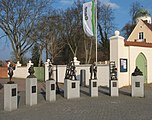Lenzen | |
|---|---|
Location of Lenzen (Elbe) within Prignitz district  | |
| Coordinates: 53°05′28″N 11°28′24″E / 53.09111°N 11.47333°E | |
| Country | Germany |
| State | Brandenburg |
| District | Prignitz |
| Municipal assoc. | Lenzen-Elbtalaue |
| Subdivisions | 9 Ortsteile |
| Government | |
| • Mayor (2024–29) | Walter Jahnke[1] |
| Area | |
| • Total | 95.75 km2 (36.97 sq mi) |
| Elevation | 19 m (62 ft) |
| Population (2022-12-31)[2] | |
| • Total | 2,038 |
| • Density | 21/km2 (55/sq mi) |
| Time zone | UTC+01:00 (CET) |
| • Summer (DST) | UTC+02:00 (CEST) |
| Postal codes | 19309 |
| Dialling codes | 038792 |
| Vehicle registration | PR |
| Website | www.lenzenelbe.de |
Lenzen (Elbe) is a small town in the district of Prignitz, in Brandenburg, Germany. The town lies to the north of the Löcknitz River, not far from where the Löcknitz flows into the Elbe. It is part of the Amt Lenzen-Elbtalaue.
Overview[edit]
Lenzen is situated near the Elbe, approx. 20 km northwest of Wittenberge. It was the scene of the Battle of Lenzen, an early victory by the Germans over the Wends in 929.
Frederick, Count of Zollern, confiscated it from the von Quitzow family in 1420 for their part in the uprising of the Wendish nobility, and mortgaged it to Otto von Blumenthal. He redeemed the mortgage and restored the von Quitzows in 1422.
Another Lenzen is an Old Prussian site in (former) East-Prussia near the Baltic Sea.
Demography[edit]

|
|
Photogallery[edit]
-
Historic view of Lenzen on a Notgeld bill from 1922 issues in Lenzen (http://www.germannotes.com)
-
Town hall
-
Castle
-
"Jester's licence"
-
Breetz
See also[edit]
- Nausdorf Canal
- Battle of Lenzen (929 AD)
References[edit]
- ^ Landkreis Prignitz Wahl der Bürgermeisterin / des Bürgermeisters. Retrieved 10 July 2024.
- ^ "Bevölkerungsentwicklung und Bevölkerungsstandim Land Brandenburg Dezember 2022" (PDF). Amt für Statistik Berlin-Brandenburg (in German). June 2023.
- ^ Detailed data sources are to be found in the Wikimedia Commons.Population Projection Brandenburg at Wikimedia Commons
External links[edit]
![]() Media related to Lenzen at Wikimedia Commons
Media related to Lenzen at Wikimedia Commons









Well, that’s interesting to know that Psilotum nudum are known as whisk ferns. Psilotum nudum is the commoner species of the two. While the P. flaccidum is a rare species and is found in the tropical islands. Both the species are usually epiphytic in habit and grow upon tree ferns. These species may also be terrestrial and grow in humus or in the crevices of the rocks.
View the detailed Guide of Psilotum nudum: Detailed Study Of Psilotum Nudum (Whisk Fern), Classification, Anatomy, Reproduction